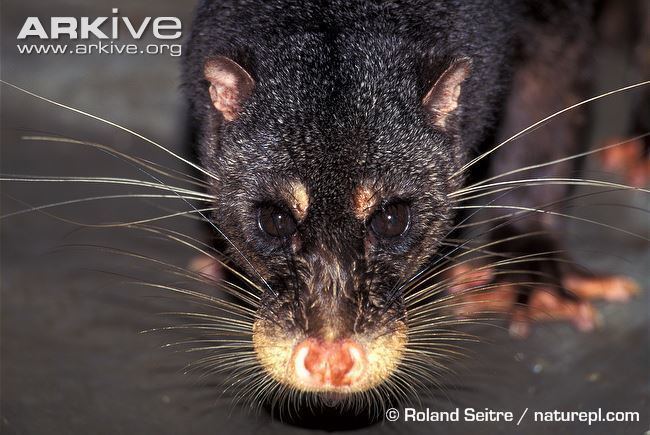Subfamily Hemigalinae Scientific name Cynogale bennettii Rank Species | Phylum Chordata Higher classification Cynogale | |
 | ||
Similar Galerella, Galidictis, Ictonyx, Galictis, Banded palm civet | ||
The otter civet (Cynogale bennettii) is a semi-aquatic civet native to Thailand, Malaysia, Indonesia and Brunei. It is listed as Endangered because of a serious ongoing population decline, estimated to be more than 50% over the past three generations (estimated to be 15 years), inferred from direct habitat destruction, and indirect inferred declines due to pollutants.
Contents
- Baby otter civet fight for milk fun
- Characteristics
- Distribution and habitat
- Ecology and behaviour
- Threats
- Conservation
- References

Cynogale is a monospecific genus.
Baby otter civet fight for milk fun
Characteristics

The otter civet possesses several adaptations to its habitat, including a broad mouth and webbed feet with naked soles and long claws. Its muzzle is long with numerous long whiskers. It is in many ways similar to the Hose's palm civet (Diplogale hosei) but has a shorter tail and no whitish underparts.
Distribution and habitat

Otter civets are distributed in Sumatra, Borneo and peninsular Thailand. Preferred habitat appears to be lowland primary forest, but they have also been recorded in secondary forest, bamboo and logged forest. The supposed origin of Lowe's otter civet (C. lowei) known only from one holotype found in 1926 in northern Vietnam was not confirmed. They are thought to be largely confined to peat swamp forests, though there are recent records from lowland dry forest.

In March 2005, an otter civet was camera trapped within an Acacia plantation in central Sarawak during 1,632 trap-nights. Between July 2008 and January 2009, ten otter civets were photographed in an area of about 112 km2 (43 sq mi) in Sabah's Deramakot Forest Reserve, a lowland tropical rainforest in Borneo ranging in altitude from 60–250 m (200–820 ft). In May 2009, the presence of otter civets was documented for the first time in central Kalimantan, where two individuals were photographed in the Sabangau Peat-swamp Forest at an elevation of about 11 m (36 ft).
Ecology and behaviour
The otter civet is a nocturnal species that obtains most of its food from the water, feeding on fish, crabs and freshwater mollusks. It can also climb to feed on birds and fruit. Given its rarity and secretive nature it is a very poorly known species.
Threats
Conversion of peat swamp forests to oil palm plantations is a major threat. There is no evidence that the species is specifically hunted, but as a ground-dwelling species it is exposed to snares and other ground-level traps set for other species. Clear-cut logging is one of the major factors contributing to decline in suitable habitat, and even selective logging may sufficiently alter habitat such that it is the species can no longer occupy it; combined, this loss of primary forest may be responsible for the current rarity of the otter civet.
Conservation
Cynogale bennettii is listed in CITES Appendix II.
